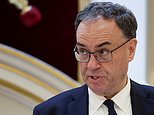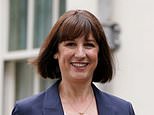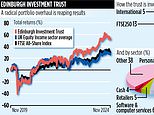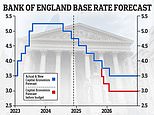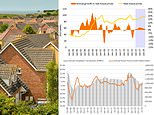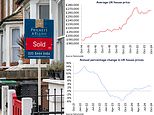House prices up 2.9% compared to a year ago - but interest rate worries could curb future growth
- Prices were up by 2.9% in the 12 months to September, according to the ONS
The average house price increased by 2.9 per cent in the 12 months to September, according to the latest figures from the Office for National Statistics.
The typical home is now selling for £292,000; an increase on the 2.7 per cent annual reading from August.
However, on a monthly basis house prices fell by 0.3 per cent reflecting the usual seasonal slowdown in the run-up to Christmas.
Rising annual house price growth is thought to have been driven by falling mortgage rates in recent months - but concerns about higher inflation and rates rising again could curb future growth according to experts.
The ONS figures run on a delay compared to other house price indexes, but are considered more accurate because they are based on completed sales.
In September, mortgage rates fell to lows not seen since before the Liz Truss mini-Budget in late 2022 which sent markets reeling.
The lowest five-year fix reached 3.68 per cent while the lowest two-year fix fell to 3.82 per cent - though these averages have risen again more recently.

Ticking up: The typical UK house price increased by 2.9% in the year to September
Emily Williams, director of research at property agent Savills said: 'Growth in September was driven by easing mortgage rates.
'We expect this pattern of growth to continue over the next few years. Despite some recent increases in mortgage rates, debt is cheaper than it was at the start of the year, and the Bank of England is likely to make more cuts to the base rate next year.'
Where did house prices rise the most?
The rate of house price growth varies across the UK.
Prices in Wales are only up 0.4 per cent over the past year, according to the ONS.
Meanwhile, in Scotland prices have jumped 5.7 per cent in the 12 months to September, and in Northern Ireland the average home is up 6.2 per cent.
Prices across England are up 2.5 per cent on average - £8,000 higher than a year ago. However, a north-south divide persists.
Prices in the North East are up 6.5 per cent on average year-on-year. Whole prices in the North West and Yorkshire and the Humber are up 4.8 per cent and 4.4 per cent respectively.
At the other end of the spectrum, average prices in London are down 0.5 per cent compared to a year ago. In the East of England, average home values are up 1.2 per cent and in the South West, prices are up just 1 per cent.
What next for house prices?
It is hard to predict what will happen to house prices and where in the country values will rise the most.
Savills is predicting the typical house price will increase 23.4 per cent over the next five years, and expects the north to see the most growth.
Meanwhile, Hamptons is forecasting that average prices will rise by by 12.5 per cent on average in the four years between the start of 2024 and end of 2027. Hamptons expects prices to rise more in the south going forward.
In recent weeks potential obstacles to house price growth have appeared. Mortgage rates have been rising with the Bank of England now likely to lower interest rates more slowly than previously expected.
Rachel Reeves' Budget has been interpreted by markets as inflationary, which has further exacerbated the feeling that interest rates will remain higher for longer.
Today, the ONS also revealed that inflation rose to 2.3 per cent in the 12 months to September, which essentially dashed hopes of an interest rate cut by the Bank of England next month.
On top of that, the chancellor increased the stamp duty surcharge on second home buyers from 3 per cent to 5 per cent. That's on top of the rates already paid by normal home movers.
Many property professionals think this will put off many buy-to-let landlords, small time developers and second home buyers from purchasing property. And when fewer buyers are in the market, prices are more likely to fall.

The jump in inflation announced today, from 1.7 per cent in September to 2.3 per cent in October, has dashed any hopes of another interest rate cut by the Bank of England (file image)
North London estate agent Jeremy Leaf said: 'While the ONS provides the most comprehensive of all the price surveys as it includes cash and mortgaged transactions, it reflects buyer and seller decision-making from a few months ago at least.
'On the ground since, we have had to contend with worries about the Budget and then its fallout.
'The result has been more caution and heavier negotiation over available properties, despite the recent drop in mortgage rates.
'Worries remain about the pace of further falls in rates and increases in inflation as buyers want to ensure they have a sufficient buffer against potentially rising costs.'
Rachael Hunnisett, director, at lender April Mortgages, added: 'The tide appears to be turning.
"Mortgage rates are creeping up again, and inflation has now climbed back above the Bank of England’s 2 per cent target, casting doubt over the strength of the housing market’s recovery.
'If interest rates are slow to fall in the coming months, we may see house price rises soften as homebuyers become more cautious and demand falls.'






